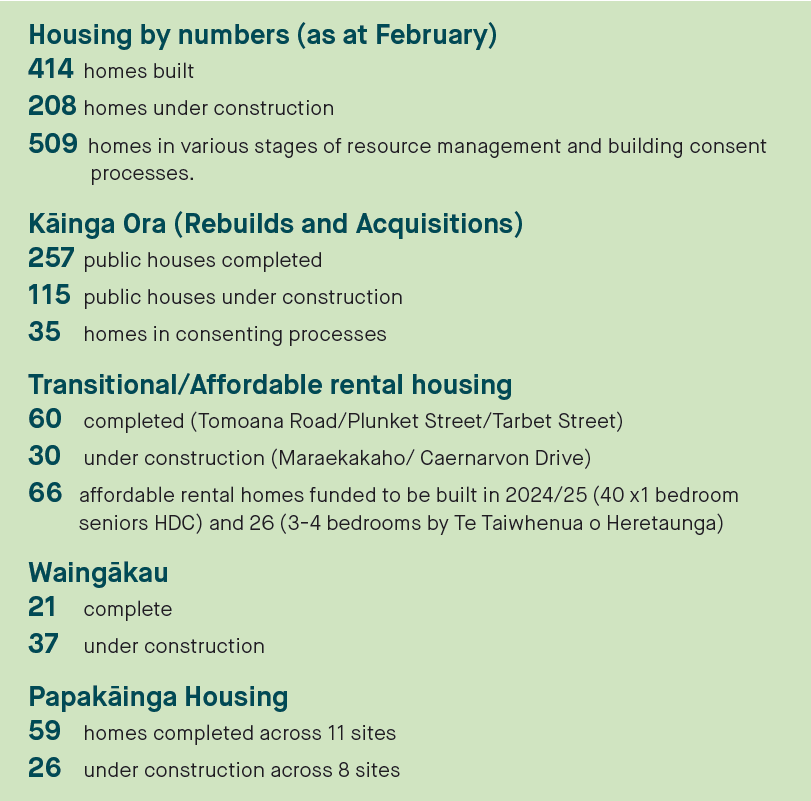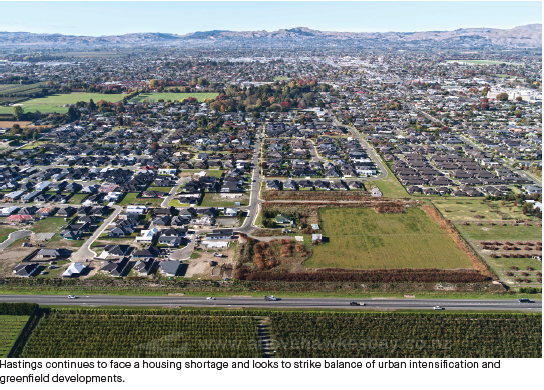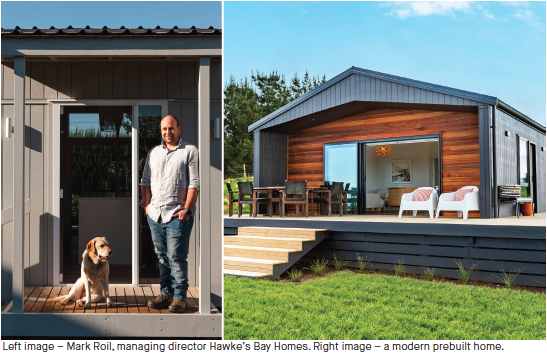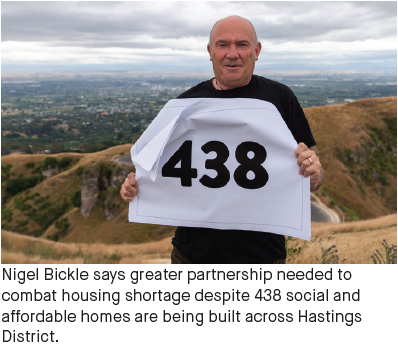Housing is one of the biggest discussion topics in Hawke’s Bay. Housing supply, urban intensification, expansion on to primary productive land, resource and building consent timelines and success, fast tracking government consents, 30 year land supply, houses vs building communities are usual parts of the conversation by planners, councils, developers, builders and government agencies.
In 2019 the region was facing a major housing shortage and Hastings District Council led a cross-organisation plan which has achieved incredible results, most notably the number of people in emergency housing plummeting from 450 in 2019 to 66 at the end of 2023.
In Hastings over the last four years 414 houses have been built and hectares of land in Iona, Brookvale, Howard Street Hastings and in Flaxmere is at various stages of construction from infrastructure servicing to houses being build. As a new government gets its feet under the desk and has already called for a review of its social housing department, Kainga Ora as well as passing legislation to repeal Labour initiated changes to the Resource Management Act, will the momentum continue?
Only the fast-track consenting scheme and the spatial planning boards survive with National keen to force councils in major towns and cities to zone for 30 years’ worth of growth immediately.
Hastings District Council chief executive Nigel Bickle is hoping to maintain the momentum that has seen more than 350 are social housing, affordable rentals, affordable first homes or papakāinga. The latest development Wairatahi, a large scale residential development in Hastings owned by Heretaunga Tamatea Pou Tahua – the commercial arm of Tamatea Pōkai Whenua, (formerly Heretaunga Tamatea Settlement Trust) has successfully gone through the Covid-19 Recovery Fast-Track Consent process.

The development will create many jobs during construction and increase housing supply by up to 450 warm homes. So how does Hastings stand up to the requirement of 30 years of housing stock? Presently Nigel estimates that the district has 1660 green fields potential lots with a further 1380 under structure planning or consenting. He thinks there’s about 10-15 years in stock and “based on a medium demand projection and including what we think the current backlog is, we estimate it is between it 8400 and 9600.”

To help supply Hastings council has two other solutions presently in consultation stages, plan change 5 that will intensify urban areas of Hastings to be subdivided and a regional Future Development Strategy, which casts the net wider, asking the community to put forward land options for development. Plan change 5 could create a further 3000 homes. With nearly 85 percent of the new housing being at the lower end of the housing ladder, council is wanting to see a rethink of hose social housing is planned and managed, focussing on building communities, rather than just houses.
Despite the success of the Hastings place-based Housing Plan, which almost eliminated emergency housing in Hastings, there’s been rinse and repeat model that has seen social housing predominantly focussed in Mahora, Mayfair and Raureka. Council is pushing for a new way of thinking with its housing partners including the government that builds strong, connected communities to uplift people and strengthen neighbourhoods. It believes the best approach is having mixed residency options within a development – rental, rent-to-buy, affordable first homes, social housing – and types and density – single, double storey, duplex designs.
Hastings Mayor Sandra Hazlehurst is adamant new developments need to be inclusive and mixed – and encourage home ownership.
“We have seen over these past few years the success home ownership brings for families that may not have had the option without alternative pathways. “By offering different options, we want to build communities and neighbourhoods with diverse populations covering ages, incomes and ethnicities.
“We must deliberately and thoughtfully address neighbourhood building, so we avoid doing what has been done in the past – segmenting people into housing developments that over time stigmatises the people who live there.”
It is particularly relevant to government-supplied social housing. “If we look at other examples – papakāinga or trust models – they have families living next to elders, people renting in one house, neighbouring someone on a plan to buy their home. Council is also keen to see funding and decision rights be locally led rather than central government agency led as well as create a fit for purpose model and partner with providers that commit to developing better community, not just houses.
Hastings has been successful in getting substantial government funding to unlock developments including $13m in grant funding for infrastructure to develop 244 Flaxmere Avenue, Flaxmere town centre and Caernarvon Drive; $1.2m infrastructure funding through the Provincial Growth Fund to develop Tarbet Street in Flaxmere.
It also received $20m to upgrade wastewater capacity to enable residential growth, including up to 50 homes being developed at Wairatahi. Te Taiwhenua o Heretaunga also received $2.5m funding assistance to accelerate the development at Waingākau and along with council $22m to deliver 66 affordable rental homes in Flaxmere through the Affordable Housing Fund.
Hawke’s Bay Homes managing director Mark Roil says they can be part of the solution to get people into housing quickly and has built houses for infill developments in Hastings. Based on the outskirts of Hastings Hawke’s Bay Homes has the capability to build up to 12 houses at a time, using a tried and tested prefabrication build process that it established in 2001 under its former Cottages NZ brand.

It has pre-approved building consent designs and plans “ready to go” as the region recovers from Cyclone Gabrielle. An average delivery of a build project takes 18-20 weeks including the build of 12 weeks. “There’s been a lot of enquiry from those that have had their homes damaged – either looking for a temporary housing solution or a new permanent home. “The rural areas of Hawke’s Bay have been the most significantly hit and for over 20 years we have been a large supplier of offsite-built housing, so we are well recognised as a trusted builder of quality homes. “As a local provider, we have built and delivered hundreds of homes across the region, navigating some difficult terrain to get houses on to some remote properties. It’s the local experience that makes the difference.”
Mark says some customers wanting a larger home can easily add-on or connect additional buildings or create a more bespoke design based from the tried and tested prefabrication build process. “Our designs have been refined over recent years and all our clients have input and add their own personalised touches such as colour of external and internal walls as well as fixtures and fittings.
Hastings based architectural designer Bryan Musson of Createus Architectural Designers has over 30 years’ experience and agrees that there is quicker solutions to the process of going from plans, consenting to living in quality warm housing.
involved across the spectrum of housing designs from social housing through to private residential projects as well as housing for the disabled. “I think council’s need to have greater confidence in respected design firms like ours, that we know the rules and regulations, a proven track record and that we have the best interests of all parties to ensure the end product is to a good quality.
“Sometimes we can get caught up in unnecessary red tape which does cause unwanted delays and frustrations.



